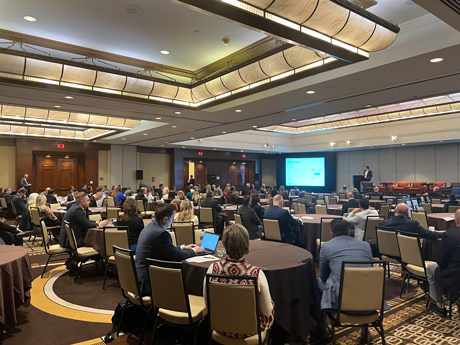LOS ANGELES — For an investor and operator, the most important factors a seniors housing company needs to have down to a science are staff recruitment and accountability, proper use of data and strong partnerships, according to Justin Dickinson, executive vice president with Pathway To Living.
“There are three near-term goals that I’m focused on: operations, data and growth,” said Dickinson, who was named as successor to retiring CEO Jerry Finis as head of Pathway to Living earlier this year.
His comments came during his keynote address at France Media’s InterFace Seniors Housing West conference, held in Los Angeles on Feb. 24. Nearly 225 industry professionals attended the event.
Dickinson is a veteran of both Welltower and CA Ventures before he landed at Waterton, a Chicago-based real estate investment and operations company. Pathway To Living is the company’s seniors housing division.
Since arriving at Waterton, Dickinson’s first priority was to flatten the corporate structure, reducing the number of layers between front-line workers and the senior vice president of operations.
“Instead of having a number of the critical tasks flowing up through the operations people, now they all report directly to the senior vice president. That creates accountability across divisions. We now have one boss, one mission and one purpose for each region. Having that level of accountability I believe will drive performance at the community level.”
Dickinson noted that, at the community level, Pathway is 22 percent below full employment. To help ease this issue, he implemented a recruiting process outsourcing (RPO) model, which allows recruiting experts to assist in getting the company fully staffed.
“They have a broader search capacity, and they allow me to have access to data. I can see where my communities and regions doing from a recruiting perspective.”
On the topic of data, Dickinson noted that Pathway partners with Yardi software to have up-to-date information on each community’s key performance indicators (KPIs). The single system allows the various departments to access the same data in the same terminology, to make sure everyone is comparing apples to apples.
“There are many ways to approach data and many systems to use. With a single system, there are fewer translation issues with the person taking that data and creating actionable reports, measuring KPI reports and holding my team accountable.”
The partnerships that Dickinson touts come in the form of co-development agreements for growing the portfolio. He hopes to invest $500 million in acquisitions this year across seven to 10 deals, he said, focused on turnaround opportunities.
From a development perspective, though, he aligns with partners that help shoulder the risk involved in a ground-up project. Partners can also have a more intimate knowledge of each individual market. Dickinson describes this is a “one plus one equals three” approach.
“I’m exploring this model because, quite frankly, I don’t want to put my whole balance sheet out there for a whole bunch of pre-development costs, nor do I want to wait a year and a half to close on a deal. There are synergies between myself and the co-development partner. For example, I want to be involved in the design since I will be operating it.”
Waterton itself serves as a sort of partner. With a total of more than 25,000 multifamily units nationwide, the parent company can provide resources such as staffing and market expertise.
“I’m looking to create a hybrid operating model between the multifamily group and the senior living group,” said Dickinson.
— Jeff Shaw


